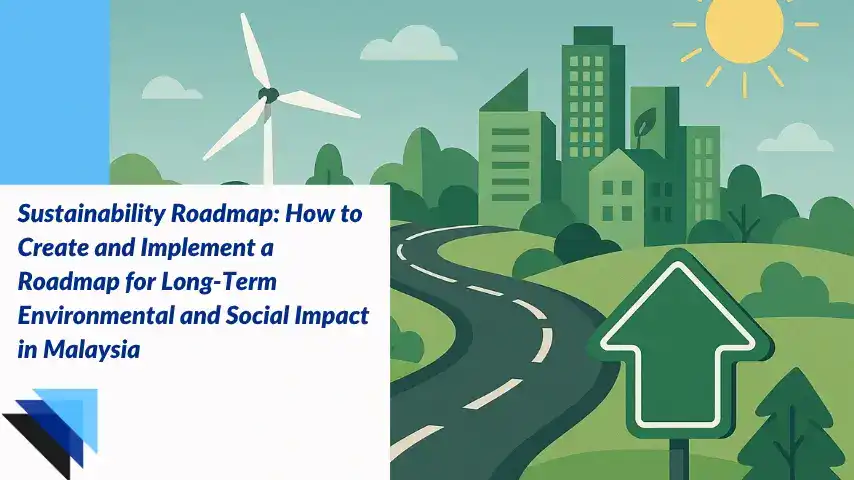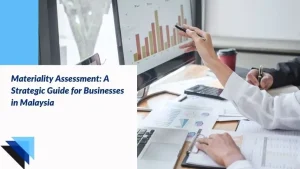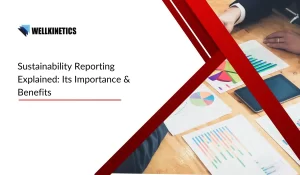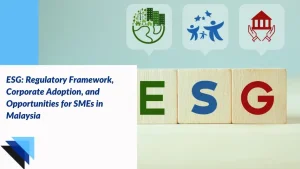A Sustainability Roadmap is a strategic framework that outlines an organization’s goals, actions, and milestones for improving its environmental, social, and governance (ESG) performance. It serves as a guiding document that helps businesses navigate the complexities of implementing sustainability initiatives while aligning with regulatory requirements and industry best practices. The roadmap typically includes assessments of current practices, identification of key sustainability challenges, and the formulation of specific, measurable, achievable, relevant, and time-bound (SMART) objectives.
In line with Malaysia’s push toward net-zero by 2050 under the National Energy Transition Roadmap and mandatory ESG disclosure through the Securities Commission’s National Sustainability Reporting Framework (NSRF), organizations must adopt structured sustainability planning tailored to both local and global standards. Therefore, creating a Sustainability Roadmap for long-term environmental and social impact in Malaysia requires strategic planning and dedicated execution.
In this detailed guide, we’ll explore how Malaysian organizations can create and implement effective Sustainability Roadmaps that drive meaningful change. From defining clear sustainability objectives to establishing measurable KPIs, we’ll walk you through the essential steps for success.
Whether you’re a business leader, sustainability professional, or organization looking to make a positive impact, this roadmap will help you:
- Develop actionable sustainability strategies
- Identify key environmental and social priorities
- Create measurable implementation frameworks
- Engage stakeholders effectively
- Track and optimize your sustainability initiatives
Let’s dive into building a Sustainability Roadmap that creates lasting positive change for Malaysia’s future.
Don’t Know Where to Start with Sustainability?
Wellkinetics helps you craft a tailored sustainability strategy that aligns with your business goals and regulatory requirements.
- What Is a Sustainability Roadmap and Why Is It Important?
- How Can Organizations Strategically Plan for Environmental Impact?
- How Can Organizations Build the Right Team Structure for a Successful Sustainability Roadmap?
- What Is the Implementation Framework for Sustainability Initiatives?
- Why Is Financial Planning and Resource Allocation Important for a Sustainability Roadmap?
- How Do You Monitor and Track Progress in Sustainability Initiatives?
- Why is a Legal and Compliance Framework Important for Sustainability Initiatives in Malaysia?
- Wrapping Up
- How Wellkinetics Can Help
What Is a Sustainability Roadmap and Why Is It Important?
A Sustainability Roadmap serves as a comprehensive strategic plan that guides organizations toward their environmental and social impact goals. It outlines the journey from current practices to desired future outcomes, ensuring a structured approach to sustainability initiatives.
What Are the Essential Elements of a Successful Sustainability Roadmap?
A well-crafted Sustainability Roadmap integrates several crucial elements that work together to drive meaningful change. At its core, it begins with a clear long-term vision that defines where the organization aims to be in terms of sustainability.
The roadmap must include specific, measurable objectives that break down the larger vision into manageable milestones. These objectives should align with both environmental priorities and business goals, creating a balanced approach to sustainable development.
Timeline planning is another vital component, establishing realistic deadlines for achieving each milestone. For Malaysian companies, this means aligning with national targets, which aim for renewable energy to reach 31 percent by 2025, 40 percent by 2035, and 70 percent by 2050. It also includes preparing for ISSB-aligned disclosures under the NSRF starting in 2025. This helps organizations maintain momentum and track progress effectively throughout their sustainability journey.
Resource allocation forms a critical part of the strategic plan, detailing the financial, human, and technological resources needed to implement sustainability initiatives. This ensures that organizations can realistically achieve their environmental goals while maintaining operational efficiency.
Stakeholder engagement strategies must be clearly defined in the roadmap, outlining how different groups will be involved in and informed about sustainability efforts. This includes internal teams, suppliers, customers, and community partners.
Regular monitoring and evaluation mechanisms should be built into the roadmap, allowing organizations to assess their progress and make necessary adjustments to their approach. This flexibility ensures the Sustainability Roadmap remains relevant and effective over time.
RELATED: Sustainability Frameworks: A Guide to Global Standards and Their Application in Malaysia
How Can Organizations Strategically Plan for Environmental Impact?
Strategic planning for environmental impact involves the systematic process of defining an organization’s long-term environmental goals and identifying the necessary steps to achieve them. This planning process requires a comprehensive analysis of both internal capabilities and external environmental factors, enabling organizations to anticipate challenges and leverage opportunities.
How Can Organizations Set Clear and Measurable Environmental Goals?
Establishing clear and measurable environmental goals is crucial for organizations committed to reducing their environmental impact. These goals should align with both sustainability objectives and broader business strategies. When setting environmental targets, it’s essential to focus on specific areas like carbon emission reduction, waste management, and resource conservation.
Organizations should adopt the SMART framework – making goals Specific, Measurable, Achievable, Relevant, and Time-bound. This approach ensures that environmental initiatives have clear metrics for success and realistic timelines for implementation. For instance, setting a target to reduce carbon emissions by 30% within five years provides a concrete objective to work towards.
It’s vital to involve key stakeholders in the goal-setting process to ensure buy-in and support across all organizational levels. This collaborative approach helps identify potential challenges and opportunities while fostering a shared commitment to environmental stewardship.
How Can Organizations Conduct a Comprehensive Risk Assessment and Manage Environmental Risks?
A comprehensive risk assessment is fundamental to understanding potential environmental impacts and developing effective mitigation strategies. Organizations must evaluate both direct and indirect risks associated with their operations, including climate-related risks, regulatory compliance, and resource scarcity.
The risk management process should include:
- Identifying potential environmental hazards
- Assessing the likelihood and severity of impacts
- Developing mitigation strategies
- Implementing control measures
- Monitoring and reviewing effectiveness
Regular environmental audits help organizations track progress toward their sustainability objectives while identifying areas for improvement. These assessments should be documented and reviewed periodically to ensure continued effectiveness and alignment with organizational goals.
Organizations should also consider emerging environmental risks and trends, such as changing regulations or new technologies, that could affect their operations. This forward-looking approach enables proactive rather than reactive risk management.
How Can Organizations Build the Right Team Structure for a Successful Sustainability Roadmap?
A successful Sustainability Roadmap requires a well-structured team with clear roles and responsibilities. Building a diverse team with complementary skills and expertise is crucial for driving environmental and social impact initiatives forward in Malaysia.
What Are the Key Stakeholder Roles and Responsibilities in a Sustainability Roadmap?
Creating a dedicated team with a multidisciplinary skill set is essential for implementing sustainability initiatives effectively. Here’s how different stakeholders contribute to the roadmap’s success:
Sustainability Director/Manager:
- Oversees the overall implementation of sustainability initiatives
- Coordinates between different departments and stakeholders
- Ensures alignment with organizational goals and objectives
- Reports progress to senior management and boards
Environmental Specialists:
- Conduct environmental impact assessments
- Develop and monitor emission reduction strategies
- Implement waste management programs
- Track environmental performance metrics
Social Impact Officers:
- Manage community engagement programs
- Develop diversity and inclusion initiatives
- Coordinate with local stakeholders
- Monitor social impact indicators
Data Analysts:
- Collect and analyze sustainability metrics
- Generate performance reports
- Identify trends and areas for improvement
- Support decision-making with data-driven insights
Project Coordinators:
- Manage day-to-day implementation of initiatives
- Track project timelines and milestones
- Coordinate with various team members
- Ensure efficient resource allocation
To maximize effectiveness, the diverse team should collaborate regularly through structured meetings and clear communication channels. Each member brings unique perspectives and expertise, contributing to a comprehensive approach to sustainability.
Once the right team is in place, the next challenge is execution. The following section explores how to embed sustainability into everyday operations.
What Is the Implementation Framework for Sustainability Initiatives?
The implementation framework serves as a structured approach to integrate sustainability initiatives into your organization’s DNA. It provides a systematic method to transform sustainability goals into actionable outcomes, ensuring long-term environmental and social impact in Malaysia.
How Can Businesses Successfully Integrate Sustainability Practices?
Successful sustainability integration requires a well-planned approach across multiple stages of sustainability integration. Let’s explore the concrete steps needed to embed sustainable practices into your business operations:
1. Strategic Alignment
- Align sustainability goals with core business objectives
- Review existing processes to identify integration points
- Develop specific action plans for each department
2. Operational Integration
- Modify standard operating procedures
- Update procurement policies to prioritize sustainable suppliers
- Implement resource efficiency measures
3. Performance Monitoring
- Establish sustainability KPIs
- Create reporting mechanisms
- Track progress against set targets
4. Cultural Transformation
- Conduct sustainability training programs
- Foster employee engagement through green initiatives
- Develop sustainability champions within teams
To ensure smooth implementation, organizations should focus on taking concrete step-by-step actions. This includes regular assessment of progress, identification of barriers, and development of mitigation strategies.
The framework should be flexible enough to accommodate changes while maintaining focus on specific action items. Regular reviews and updates help maintain momentum and ensure continuous improvement in sustainability performance.
Remember to document best practices and lessons learned throughout the implementation process. This knowledge base becomes invaluable for future initiatives and helps create a culture of sustainable business practices.
Looking for Expert Support in Sustainability Implementation?
Partner with Wellkinetics for hands-on support in executing your sustainability strategy, from start to finish.
Why Is Financial Planning and Resource Allocation Important for a Sustainability Roadmap?
Effective financial planning and resource allocation are crucial components of a successful Sustainability Roadmap. Organizations must carefully balance their sustainability goals with available resources to ensure long-term success. A well-designed business strategy that incorporates sustainability initiatives requires thorough financial assessment and planning.
How Do You Budget for Sustainability Initiatives?
Strategic financial planning begins with a comprehensive evaluation of the costs associated with implementing sustainability projects. This includes both initial investments and ongoing operational expenses. Organizations should consider:
- Infrastructure upgrades and modifications
- Technology investments
- Training and development programs
- Monitoring and reporting systems
- External consultancy fees
Creating a strong business case for sustainability initiatives helps secure stakeholder buy-in and necessary funding. This involves:
- Calculating potential cost savings from improved resource efficiency
- Identifying new revenue opportunities
- Estimating risk reduction benefits
- Analyzing competitor sustainability investments
- Projecting long-term financial returns
Organizations should also consider various funding sources such as:
- Internal capital allocation
- Government grants and incentives
- Green financing options (e.g., “Green Investment Tax Allowance [GITA]”)
- Partnership opportunities
- Carbon credit trading
Successful implementation requires regular review and adjustment of financial allocations based on performance metrics and changing market conditions. This ensures resources are optimally utilized and sustainability goals remain achievable within budget constraints.
Facing Challenges in Resource Allocation?
Wellkinetics helps you optimize resources, ensuring every dollar spent works toward achieving your sustainability objectives.
How Do You Monitor and Track Progress in Sustainability Initiatives?
The success of a Sustainability Roadmap heavily depends on systematic monitoring and evaluation of initiatives. Regular tracking helps organizations identify areas of improvement and ensure they’re making good progress towards their sustainability objectives.
What Are the Key Performance Metrics and KPIs for Sustainability Initiatives?
Establishing clear performance metrics is crucial for measuring the effectiveness of sustainability initiatives. Organizations should align their metrics with international standards and industry benchmarks to ensure credible reporting. These measurements should encompass both quantitative and qualitative aspects of sustainability performance.
When selecting KPIs, focus on metrics that directly relate to your ESG-related goals. For instance, if carbon reduction is a priority, track metrics like:
- Total greenhouse gas emissions
- Energy consumption from renewable sources
- Carbon intensity per unit of production
- Waste reduction percentages
- Water usage efficiency
Organizations should implement robust data collection systems to ensure accurate measurement and reporting. This involves:
1. Regular data collection intervals
2. Standardized measurement methodologies
3. Clear documentation procedures
4. Quality control measures
5. Independent verification processes
It’s essential to review and adjust these metrics periodically to ensure they remain relevant and aligned with evolving sustainability objectives. Consider implementing automated tracking systems to streamline data collection and analysis, making the monitoring process more efficient and reliable.
Remember to communicate progress regularly to stakeholders through sustainability reports and updates. This transparency helps maintain accountability and demonstrates commitment to sustainability goals.
Why is a Legal and Compliance Framework Important for Sustainability Initiatives in Malaysia?
Legal compliance forms the backbone of any Sustainability Roadmap in Malaysia, serving as a crucial framework that organizations must navigate to ensure their environmental and social initiatives align with national regulations.
What Are the Regulatory Requirements for Sustainability in Malaysia?
Malaysia’s legal landscape for sustainability encompasses various environmental protection acts and social responsibility guidelines. Organizations must stay compliant with key regulations such as the new mandatory sustainability reporting (NSRF), the Environmental Quality Act 1974 and the National Policy on Climate Change.
Government relations play a vital role in maintaining compliance standards. Companies need to establish strong partnerships with regulatory bodies and maintain open communication channels to stay updated on evolving requirements.
Environmental compliance is considered a distinct discipline from general corporate compliance, requiring specialized knowledge and dedicated resources. Organizations must develop comprehensive monitoring systems to track their adherence to environmental regulations and social responsibility guidelines.
Malaysian businesses must also comply with international standards and agreements that the country has ratified, including various UN conventions on environmental protection and sustainable development. This dual compliance approach ensures both local and global sustainability standards are met.
Regular audits and assessments help organizations identify potential compliance gaps and implement necessary corrective measures. Companies should maintain detailed documentation of their compliance efforts and establish clear reporting mechanisms.
ALSO READ: Sustainability Reporting Explained: Its Importance & Benefits
Worried About Compliance With Sustainability Laws?
With Wellkinetics, you’ll always be compliant with the latest local and international sustainability standards.
Wrapping Up
Developing a sustainability roadmap is more than a compliance exercise; it’s a chance to future-proof your organization, reduce risk, and unlock long-term value. By aligning your environmental and social goals with Malaysia’s national targets, embedding sustainability into core operations, and continuously monitoring performance, your organization can drive real, measurable impact.
Key takeaways from this guide:
- A well-defined vision and SMART goals are the foundation of any successful roadmap.
- Cross-functional teams and strong governance are essential for execution.
- Regular risk assessments, KPI tracking, and stakeholder engagement ensure accountability and progress.
- Alignment with frameworks like the National Energy Transition Roadmap (NETR) and NSRF is critical for regulatory readiness in Malaysia.
Whether you are just starting or already have ESG initiatives in place, your roadmap should evolve with your business and the changing sustainability landscape.
How Wellkinetics Can Help
At Wellkinetics, we understand that navigating the complexities of sustainability can be challenging for organizations in Malaysia. Our mission is to empower businesses with tailored solutions that align with their sustainability objectives while ensuring compliance with legal requirements. Here’s how we can assist you in your sustainability journey:
1. Tailored Consultancy Services: Our team of experts specializes in providing customized consultancy services that address your unique sustainability challenges. We help identify opportunities for improvement in your practices, setting realistic and measurable goals in line with your organizational objectives.
2. Comprehensive Training Programs: Knowledge is key to effective sustainability practices. We offer comprehensive training programs designed to educate your team about the importance of ESG principles, compliance requirements, and best practices for monitoring and reporting. Empowering your employees with the necessary skills can lead to better implementation and commitment across all levels of the organization.
3. Compliance Audits and Risk Assessments: Navigating legal frameworks can be daunting. We conduct thorough compliance audits and risk assessments to identify gaps in your sustainability practices. Our proactive approach includes recommendations to enhance compliance with local and international regulations, ensuring that your organization meets its obligations and minimizes risks.
4. Sustainability Roadmap Development: Wellkinetics helps you create a structured Sustainability Roadmap that aligns with your business goals and regulatory requirements. Our consultants will work alongside your team to outline clear milestones and action steps, ensuring you stay on track toward achieving your sustainability objectives.
5. Stakeholder Engagement Strategies: Engaging stakeholders is crucial for the success of sustainability initiatives. We assist in developing effective communication strategies that facilitate meaningful dialogues with your internal and external stakeholders. Building strong relationships can bolster support for your sustainability efforts and enhance your organization’s reputation.
6. Continuous Improvement Frameworks: Sustainability is an ongoing journey. At Wellkinetics, we believe in establishing continuous improvement frameworks that enable you to regularly assess and refine your practices. We help set up feedback loops and performance indicators, allowing your organization to adapt to changing regulations and stakeholder expectations over time.
7. Implementation Support: Beyond planning, we provide hands-on support during the implementation of your sustainability initiatives. Our team is dedicated to assisting in the execution of projects that drive sustainability, ensuring that your strategy is applied effectively and efficiently.
8. Reporting and Communication Services: Transparent reporting is vital to demonstrating your commitment to sustainability. We offer services to help you develop clear and impactful sustainability reports that highlight your achievements and align with international reporting standards, fostering trust and accountability among stakeholders.
Learn more about our ESG consultancy services.




